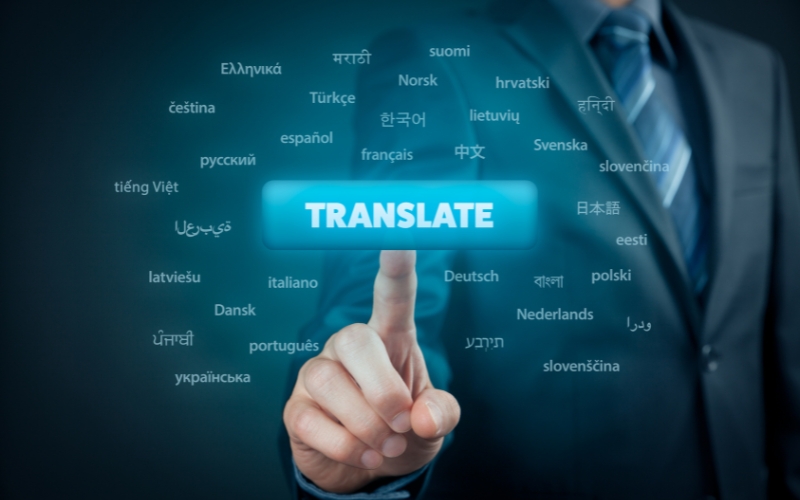In today’s globalized world, creating a multi-language website is essential for businesses looking to expand their reach and connect with a diverse, international audience. However, building a website that effectively communicates across different languages involves more than just translation. It requires careful consideration of various factors, including the translation strategy, design elements, and search engine optimization (SEO) techniques. By choosing the right translation approach, ensuring a seamless and culturally relevant design, and optimizing content for search engines, businesses can create a website that is not only accessible but also appealing to a global audience. This article explores the key steps to building a successful multi-language website, covering translation options, design best practices, and SEO strategies that will ensure your site resonates with users from all around the world.
Choosing the Right Translation Strategy: Manual vs. Automated Translation

When creating a multi-language website for global reach, one of the most critical decisions is selecting the right translation strategy. You have two main options: manual translation by professionals or automated translation tools. Both approaches have their advantages and disadvantages, and the best choice for your website will depend on your budget, target audience, and content complexity.
Manual Translation: The Professional Approach
Manual translation involves hiring professional translators who are fluent in the target language and familiar with the cultural nuances of the region. This approach offers several key benefits:
- Accuracy and Quality: Professional translators ensure that the meaning and tone of the content are accurately conveyed. Unlike automated tools, which may misinterpret complex phrases or idioms, manual translation provides the necessary context for the content to resonate with the target audience. This is particularly important for businesses that want to maintain a high level of professionalism and avoid errors that could damage their reputation.
- Cultural Relevance: Human translators are better equipped to adapt content to different cultural contexts. They can ensure that the language used is appropriate for local customs, legal requirements, and consumer preferences. For example, certain phrases or images may have different connotations in different cultures, and a professional translator can adjust your content to avoid misunderstandings.
- SEO Considerations: Professional translators who specialize in SEO know how to optimize your content in the target language. This includes selecting appropriate keywords, ensuring the correct use of local search terms, and structuring content for search engine rankings in the target country. This is crucial for achieving visibility in foreign markets.
However, manual translation also has some drawbacks:
- Cost: Hiring professional translators can be expensive, especially if you’re translating a large volume of content. The cost is often based on word count, and the rates can vary depending on the language pair and expertise required.
- Time-Consuming: Translating content manually takes time, and for websites with dynamic content or frequent updates, it can be challenging to keep up with the translation process. A professional translation team may need more time to deliver accurate and high-quality translations.
Automated Translation: The Tech-Savvy Alternative
Automated translation tools, such as Google Translate, DeepL, and AI-powered translation platforms, offer a faster and more cost-effective alternative to manual translation. These tools have become increasingly sophisticated, making them a popular choice for many businesses. Here are some of the benefits:
- Speed: Automated translation tools can quickly translate large amounts of content, making them ideal for websites with a vast volume of text that needs to be translated rapidly. This is particularly useful for businesses that need to update their website regularly with new product information or blog posts.
- Cost-Effective: Automated translation is generally much cheaper than hiring a professional translator. This makes it an appealing option for small businesses or startups with limited budgets who still want to expand into international markets.
- Scalability: As your business grows and you add more content or expand into additional languages, automated translation tools can easily handle the increase in volume. This scalability allows you to maintain a consistent translation strategy across multiple languages without the need for a large translation team.
Despite its advantages, automated translation has several limitations:
- Accuracy Issues: While automated tools have improved significantly, they still struggle with nuances, idioms, and complex sentence structures. These tools often provide literal translations, which can result in awkward or incorrect phrasing. This may affect the clarity and professionalism of the website content.
- Lack of Cultural Sensitivity: Automated tools do not take into account cultural nuances, which could lead to misinterpretations or inappropriate content. For example, jokes or references that work in one culture might not translate well in another, leading to a disconnect with the audience.
Which Strategy Is Right for You?
The decision between manual and automated translation largely depends on your budget, target audience, and the complexity of your content. If your business is aiming for a high-end, professional image in international markets, and you have the budget for it, manual translation is likely the better choice. It ensures accuracy, quality, and cultural relevance.
However, if you’re working with a tight budget or need to quickly expand into new markets, automated translation can be a viable solution. For websites with less complex content, such as product descriptions or blog posts, automated translation can be a quick and cost-effective option.
In some cases, a hybrid approach can also work well. For instance, you could use automated translation for basic content and then have professional translators review and refine the translations to ensure quality and accuracy. This can provide a good balance between speed, cost, and quality, helping you create a multi-language website that effectively reaches global audiences.
Design Considerations for a Seamless Multi-Language Experience

Designing a multi-language website requires careful consideration of several key design aspects to ensure that the site remains user-friendly and professional across different languages. These factors include layout flexibility, font selection, and accommodating cultural differences in design elements. Each of these elements plays a crucial role in creating an experience that resonates with a diverse, global audience.
1. Layout Flexibility for Multiple Languages
One of the most important design considerations when creating a multi-language website is ensuring that the layout can adapt to different languages. Languages vary not only in the number of characters but also in text direction and word length. For example, languages such as English or Spanish use a left-to-right reading order, while languages like Arabic or Hebrew are read from right to left. Therefore, your website’s layout must be flexible enough to accommodate these differences.
Responsive design is essential here. The layout should adjust dynamically to different screen sizes, but it also needs to adjust based on the text’s flow. When switching from left-to-right languages to right-to-left ones, for example, navigation buttons, text alignment, and images may need to shift accordingly. By building flexible layouts using relative units (like percentages or ems) rather than fixed pixel values, the design can accommodate changes in text length and reading direction without breaking the overall user experience.
Moreover, longer words or sentences in languages such as German or Russian may take up more space than their English counterparts. It’s crucial to design with enough padding or space to ensure that the content doesn’t look cramped or spill over the edges of its containers.
2. Font Selection for Clear Readability
Font selection is another critical factor in ensuring that a multi-language website is readable and aesthetically pleasing across all languages. While some fonts work well across different languages, others may not support certain characters or have different appearances in non-Latin scripts. For instance, while a font may look great in English, it may not support Cyrillic characters or Chinese characters properly.
Web-safe fonts such as Arial, Times New Roman, and Helvetica are common, but they might not be ideal for all languages. It’s essential to test fonts across all languages to ensure they render well. Some fonts may distort characters or make them difficult to read, especially when dealing with languages that use non-Latin alphabets, like Chinese, Japanese, or Arabic.
Furthermore, font size plays a role in readability. Some languages, such as Chinese or Japanese, might require slightly different font sizes to maintain legibility, as their characters can be more complex and denser than in English. Therefore, it’s important to design with sufficient line spacing and font size scalability to ensure the text remains readable in every language.
3. Cultural Differences in Design Elements
In a multi-language website, cultural differences must be considered in both visual and functional design elements. What works well in one country might be less effective or even offensive in another. For example, the color red symbolizes good luck and prosperity in many cultures, particularly in China, but in some Middle Eastern countries, it may be associated with danger or warning. Colors, symbols, and images should be carefully selected to avoid miscommunication or unintentional offense.
Imagery should also be chosen with cultural context in mind. Images that feature people should reflect the diversity of your global audience. For instance, showing people from different ethnicities or backgrounds in your visual content will help users feel more connected to the website. It’s essential to use images that are culturally appropriate, avoiding stereotypes and respecting local traditions and values.
Localization of icons and buttons is also important. The meaning of certain icons can differ from one culture to another. For example, the shopping cart icon may be universally understood in many regions, but other icons like the hamburger menu may be less familiar in some cultures. Ensure that the icons and UI elements you use are intuitive and localized, considering how different cultures might interpret them.
Conclusion
When designing a multi-language website, it’s vital to create a seamless, user-friendly experience for a global audience. By considering layout flexibility, carefully selecting fonts that support all languages, and addressing cultural differences in design, you can ensure your website is both professional and accessible. Ultimately, a well-designed multi-language website will not only improve the user experience but also enhance your brand’s reputation and engagement with international customers.
SEO Best Practices for Multi-Language Websites

When creating a multi-language website, optimizing for search engines is crucial to ensuring that each version of the site ranks well in search results. A strong SEO strategy will not only help your site reach a global audience but also enhance user experience by delivering content in the appropriate language. To achieve this, it’s important to implement a combination of techniques, including hreflang tags, language-specific content creation, and keyword localization. These strategies will help ensure that search engines can correctly index and serve the right content to the right users.
1. Using Hreflang Tags to Signal Language and Regional Targeting
Hreflang tags are a key component in ensuring that search engines know which language version of a page to serve to users based on their location and language preferences. These tags are HTML attributes that indicate the language and region of a page, allowing search engines to serve the most relevant version of the page to users in different geographical locations.
It’s important to use correct hreflang tags for each language and regional version of your site. Misuse or omission of hreflang tags can result in search engines showing the wrong version of your website to users, which can negatively impact both user experience and SEO rankings.
2. Creating Language-Specific Content
When targeting multiple languages, it’s crucial to create language-specific content that resonates with your audience. This goes beyond just translating text; it involves adapting the content to the local culture, preferences, and behaviors of the target market. For example, an offer or promotion that works in one country might not appeal to users in another.
Additionally, search engines prefer content that is written specifically for a particular language rather than relying on automated translation tools. While automated translation tools like Google Translate can quickly translate text, they often fail to capture nuances, idioms, or the cultural tone of the language. For SEO purposes, professionally translated content that speaks directly to the audience in their native language is far more effective.
Moreover, content length and structure may vary between languages. For example, some languages tend to use longer words and phrases (such as German or Russian), meaning that text blocks and headlines might need to be restructured to avoid overcrowding or breaking the layout. This also helps maintain a high-quality user experience, which indirectly benefits SEO.
3. Keyword Localization for Better Search Visibility
Keyword localization is an essential part of SEO for multi-language websites. It’s not enough to translate the keywords from one language to another—keywords must be tailored to the specific market and language. In some cases, keywords that work well in one region may not be popular or effective in another.
For example, the word “car” in English may be searched as “auto” or “automobile” in different languages or regions. Similarly, phrases that are commonly used in one country might not be as relevant in another. To optimize for different languages, conduct local keyword research to identify the terms and phrases that users in each target market are searching for. This ensures that your content is aligned with local search intent and increases the chances of ranking well for relevant queries.
In addition to choosing the right keywords, it’s also important to implement these keywords naturally within the content. This includes placing them in page titles, meta descriptions, headings, and throughout the text in a way that makes sense for the language and context. Overloading the content with keywords, known as keyword stuffing, can harm your rankings and readability, so balance is key.
Conclusion
To maximize the SEO potential of a multi-language website, it’s essential to properly use hreflang tags, create high-quality language-specific content, and localize keywords for each target market. These practices ensure that search engines can correctly index and serve the right version of your website to users around the world, ultimately helping you attract the right audience and improve your search engine visibility. By implementing these best practices, you will not only optimize for search engines but also enhance the overall user experience, which is critical for building brand trust and engagement across different markets.

